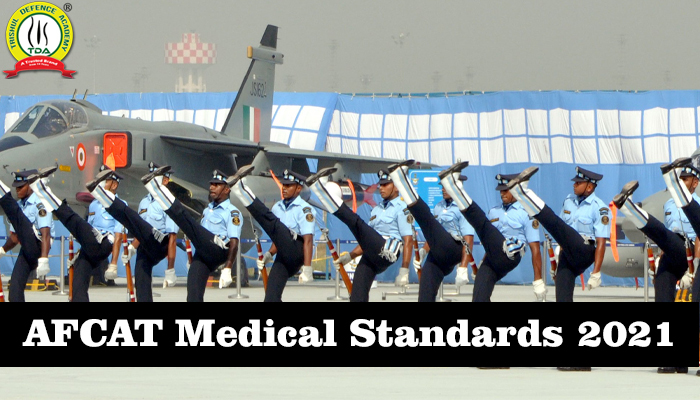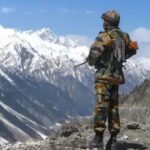WordPress database error: [Table './trishlldefenceac_def/wp_post_views' is marked as crashed and should be repaired]SELECT SUM(count) AS views
FROM wp_post_views
WHERE id IN (10834) AND type = 4
AFCAT Medical Standards: Air Force Common Admission Test also known as (AFCAT) is the selection test conducted by the Indian Air Force (IAF) for the enlistment of officers. The AFCAT test is directed twice each year in February and September. Through AFCAT, IAF fills the opening of officer rank posts in different offices including Flying Branch, Technical Branch and Ground Duty Branch.
Candidates who clear AFCAT are called up for a 5-day SSB interview process at one of the selection centres of defence forces. SSB or Services Selection Board, the meeting tests the psychological capacity, physical fitness, communication skills, natural abilities and different characteristics of a candidate.
Candidates who qualify the SSB round are then required to clear a medical examination test in which their physicality and wellness are estimated and contrasted with the physical and medical standards of IAF (Indian Air Force).
Consistently, AFCAT releases the physical and medical standards alongside the official notification for the test. In this article, we cover the physical and medical standards needed for AFCAT. Applicants who don’t fulfil the said standards won’t be enlisted into the flying wing of the Indian Air Force.
Physical and Medical Standards for AFCAT
Working in the Defense Forces is a trustworthy yet exceptionally requesting position. The work expects officers to not exclusively be fit as a fiddle yet additionally be medicinally fit and intellectually solid to deal with the necessities of the work. Thusly, IAF needs to guarantee that an applicant is truly and medicinally fit to fill in as an official in the Air Force.
Each candidate for AFCAT needs to go through a physical and medical standards test in which they are completely checked to be a medically fit. Physical attributes of the applicant, for example, their height and weight are additionally estimated and recorded.
Height and Weight Standards for AFCAT
Candidates can check the branch-wise height and weight standard for male and female applicants given beneath. Applicants who are discovered to be overweight according to the predetermined guidelines are given with a letter of alert and they need to diminish their weight to the predefined standard before they report for the medical test.
Height Standards for Flying Branch of IAF
Given below is the maximum and minimum height standard for male and female candidates for the flying branch of the Indian Air Force. No concession is given to any competitor in these boundaries.
| Parameter | Min. (in cms) | Max (in cms) |
| Acceptable Height | 162.5 | — |
| Leg Length | 99 | 120 |
| Thigh Length | — | 64 |
| Sitting Height | 81.5 | 96 |
Height Standards for Ground Duty Branch of IAF
The height standards for male and female candidates for Ground Duty (Technical / Non-Technical) branch of IAF can be found given below.
| Parameter | Min. (in cms) | Max. (in cms) |
| Acceptable Height for Males | 157.5 | — |
| Acceptable Height for Females | 152 | — |
Height and Weight Standards for Male |
|||||||
| Height (in cm)
Without Shoes |
Age Range (in Years) / Weight (in Kgs) | ||||||
| 15-17 | 18-22 | 23-27 | 28-32 years | 33-37years | |||
| 152 | 46 | 47 | 50 | 54 | 54 | ||
| 153 | 47 | 47 | 51 | 55 | 55 | ||
| 154 | 47 | 48 | 51 | 56 | 56 | ||
| 155 | 48 | 49 | 52 | 56 | 56 | ||
| 156 | 48 | 49 | 53 | 57 | 57 | ||
| 157 | 49 | 50 | 54 | 58 | 58 | ||
| 158 | 49 | 50 | 54 | 58 | 58 | ||
| 159 | 50 | 51 | 55 | 59 | 59 | ||
| 160 | 51 | 52 | 56 | 59 | 60 | ||
| 161 | 51 | 52 | 56 | 60 | 60 | ||
| 162 | 52 | 53 | 57 | 61 | 61 | ||
| 163 | 52 | 54 | 58 | 61 | 62 | ||
| 164 | 53 | 54 | 59 | 62 | 63 | ||
| 165 | 53 | 55 | 59 | 63 | 63 | ||
| 166 | 54 | 56 | 60 | 63 | 64 | ||
| 167 | 54 | 56 | 61 | 64 | 65 | ||
| 168 | 55 | 57 | 61 | 65 | 65 | ||
| 169 | 55 | 57 | 62 | 65 | 66 | ||
| 170 | 56 | 58 | 63 | 66 | 67 | ||
| 171 | 56 | 59 | 64 | 66 | 68 | ||
| 172 | 57 | 59 | 64 | 67 | 68 | ||
| 173 | 58 | 60 | 65 | 68 | 69 | ||
| 174 | 58 | 61 | 66 | 68 | 70 | ||
| 175 | 59 | 61 | 66 | 69 | 71 | ||
| 176 | 59 | 62 | 67 | 70 | 71 | ||
| 177 | 60 | 62 | 68 | 70 | 72 | ||
| 178 | 60 | 63 | 69 | 71 | 73 | ||
| 179 | 61 | 64 | 69 | 72 | 73 | ||
| 180 | 61 | 64 | 70 | 72 | 74 | ||
| 181 | 62 | 65 | 71 | 73 | 75 | ||
| 182 | 62 | 66 | 72 | 74 | 76 | ||
| 183 | 63 | 66 | 72 | 74 | 76 | ||
| 184 | 64 | 67 | 73 | 75 | 77 | ||
| 185 | 64 | 68 | 74 | 75 | 78 | ||
| 186 | 65 | 68 | 74 | 76 | 78 | ||
| 187 | 65 | 69 | 75 | 77 | 79 | ||
| 188 | 66 | 69 | 76 | 77 | 80 | ||
| 189 | 66 | 70 | 77 | 78 | 81 | ||
| 190 | 67 | 71 | 77 | 79 | 81 | ||
| 191 | 67 | 71 | 78 | 79 | 82 | ||
| 192 | 68 | 72 | 79 | 80 | 82 | ||
| 193 | 68 | 73 | 79 | 81 | 83 | ||
| +/- SD | 6 | 6.3 | 7.1 | 6.6 | 6.9 | ||
These were the endorsed physical and clinical guidelines for AFCAT. Check the connected articles given underneath for more data about the AFCAT test.
Height and Weight standards for Female |
|||||||
| Height (in cm) Without Shoes | Age Range (in Years) / Weight (in Kgs) | ||||||
| 20-25 Years | 26-30 Years | ||||||
| 148 | 43 | 46 | |||||
| 149 | 44 | 47 | |||||
| 150 | 45 | 48 | |||||
| 151 | 45 | 48 | |||||
| 152 | 46 | 49 | |||||
| 153 | 47 | 50 | |||||
| 154 | 47 | 50 | |||||
| 155 | 48 | 51 | |||||
| 156 | 49 | 52 | |||||
| 157 | 49 | 53 | |||||
| 158 | 50 | 53 | |||||
| 159 | 51 | 54 | |||||
| 160 | 51 | 55 | |||||
| 161 | 52 | 55 | |||||
| 162 | 52 | 56 | |||||
| 163 | 53 | 57 | |||||
| 164 | 54 | 57 | |||||
| 165 | 54 | 58 | |||||
| 166 | 55 | 59 | |||||
| 167 | 56 | 60 | |||||
| 168 | 56 | 60 | |||||
| 169 | 57 | 61 | |||||
| 170 | 58 | 62 | |||||
| 171 | 58 | 62 | |||||
| 172 | 59 | 63 | |||||
| 173 | 59 | 64 | |||||
| 174 | 60 | 64 | |||||
| 175 | 61 | 65 | |||||
| 176 | 61 | 66 | |||||
| 177 | 62 | 67 | |||||
| 178 | 63 | 67 | |||||
| +/- SD | 5 | 5 | |||||
AFCAT Visual Standards for Different Branches
IAF likewise checks the eyes of a candidate for any deformities. Candidates applying for IAF should have great vision according to the guidelines indicated by AFCAT. The visual standard indicated by the IAF for its various branches is mentioned below.
| Branch | Maximum Limits of Refractive Error | Visual Acuity Errors | Colour Vision |
| F (P) including WSOs | Hypermetropia: + 2.0D Sph
Manifest Myopia: Nil Retinoscopic myopia: – 0.5 in any meridian permitted Astigmatism: + 0.75D Cyl (within + 2.0D Max) |
6/6 in one eye and 6/9 in other
Correctable to 6/6 only for Hypermetropia |
CP-I |
| Aircrew other than F(P) | Hypermetropia: +3.5D Sph
Myopia: -2.0D Sph Astigmatism: + 0.75D Cyl |
6/24 in one eye and 6/36 in other
Correctable to 6/6 and 6/9 |
CP-I |
| Adm / Adm (ATC) / Adm (FC) | Hypermetropia: + 3.5D Sph
Myopia: -3.5D Sph Astigmatism: + 2.5D Cyl in any meridian |
Corrected visual acuity should be 6/9 in each eye | CP-II |
| AE(M) AE(L) |
Hypermetropia: + 3.5D Sph
Myopia: -3.50 D Sph Astigmatism:+ 2.5D Cyl in any meridian |
Corrected visual acuity should be 6/9 in each eye
Wearing glasses will be compulsory when advised |
CP-II |
| Met | Hypermetropia: + 3.5 D Sph
Myopia: -3.50 D Sph Astigmatism:+ 2.50 D Cyl |
Corrected visual acuity should be 6/9 in each eye.
Wearing glasses will be compulsory when advised |
CP-II |
| Accts / Lgs / Edn | Hypermetropia: + 3.5 D Sph
Myopia: -3.50 D Sph Astigmatism:+ 2.50 D Cyl |
Corrected visual acuity should be 6/6 in the better eye and 6/18 in the worse eye.
Wearing of Glasses will be compulsory. |
CP-III |



